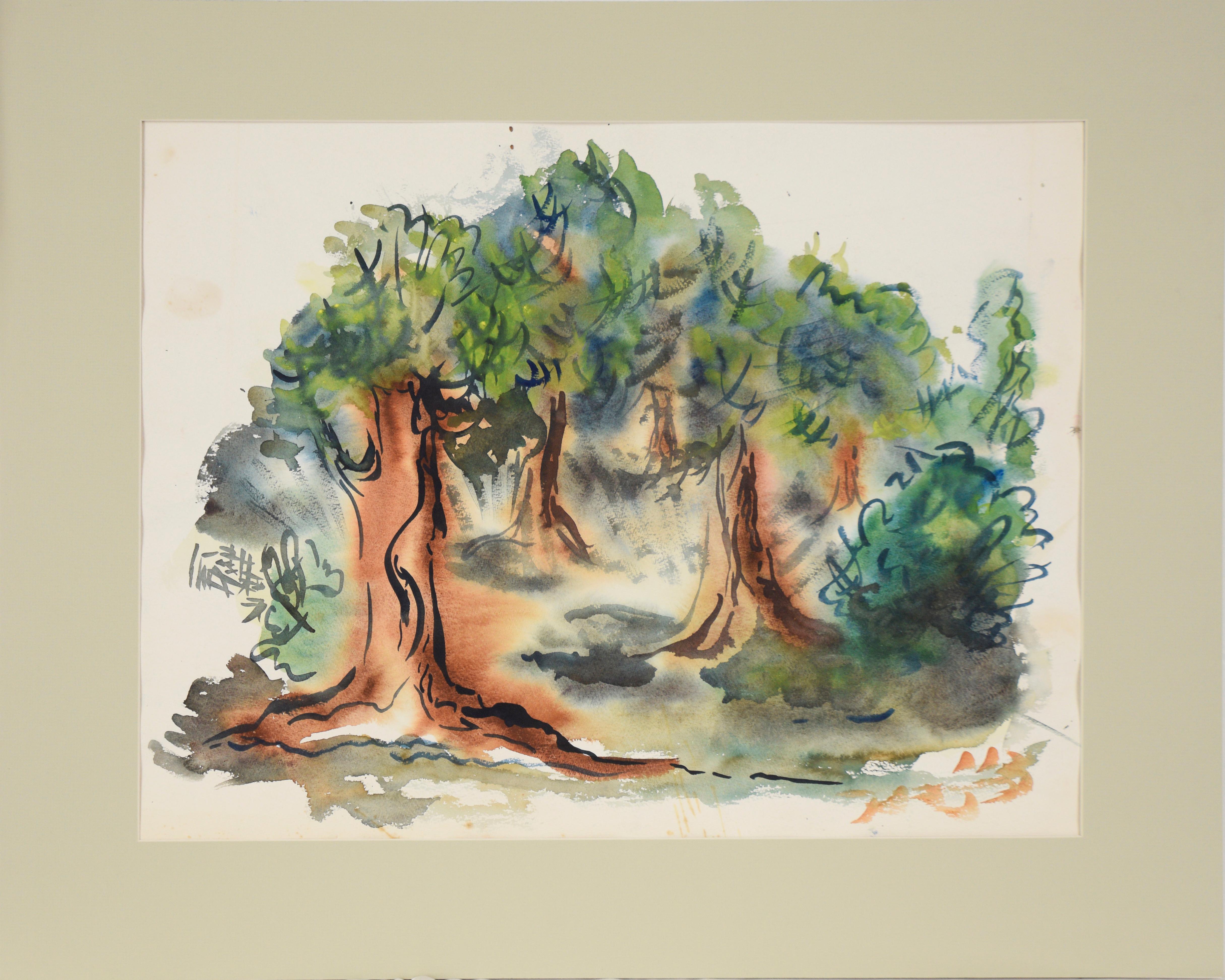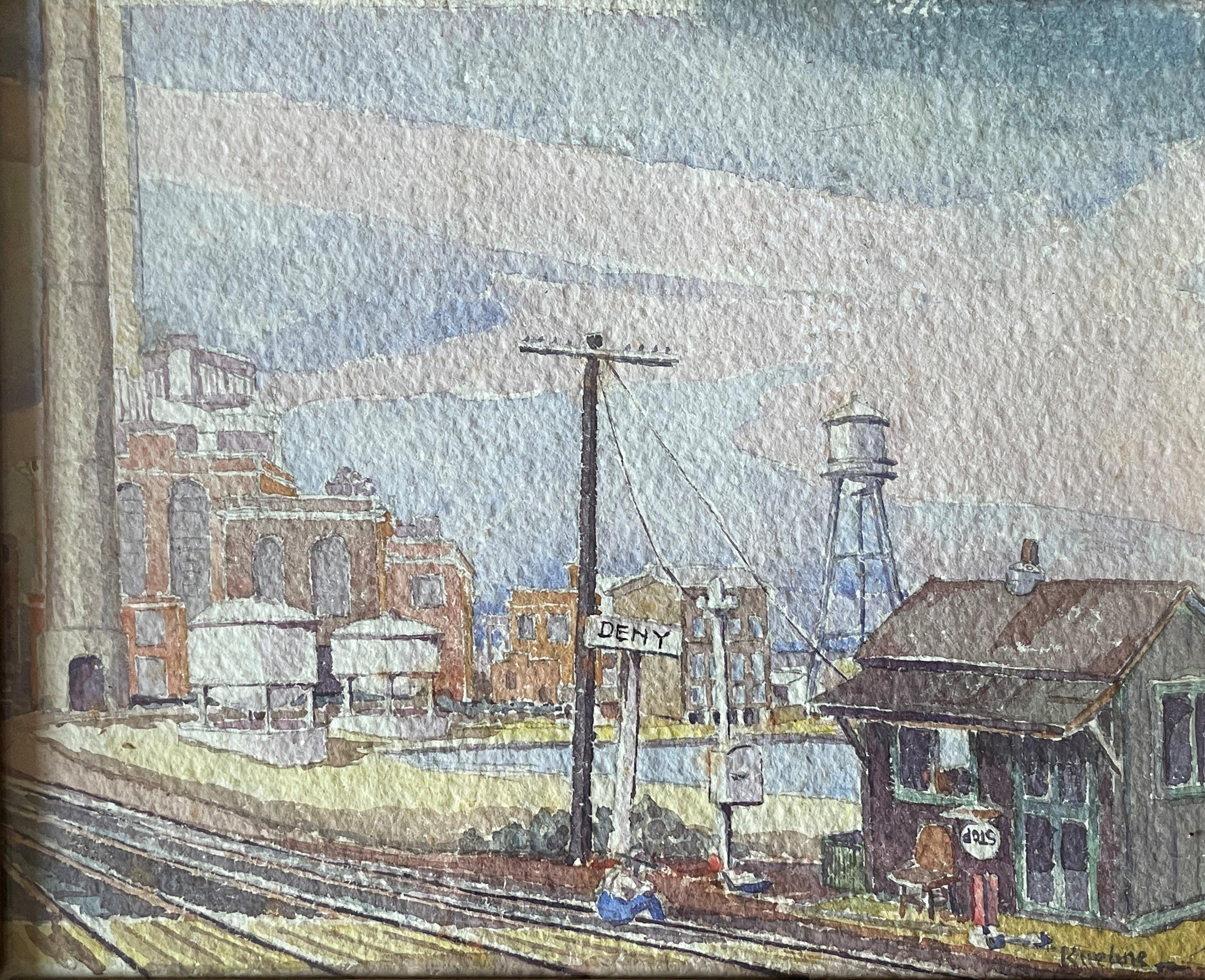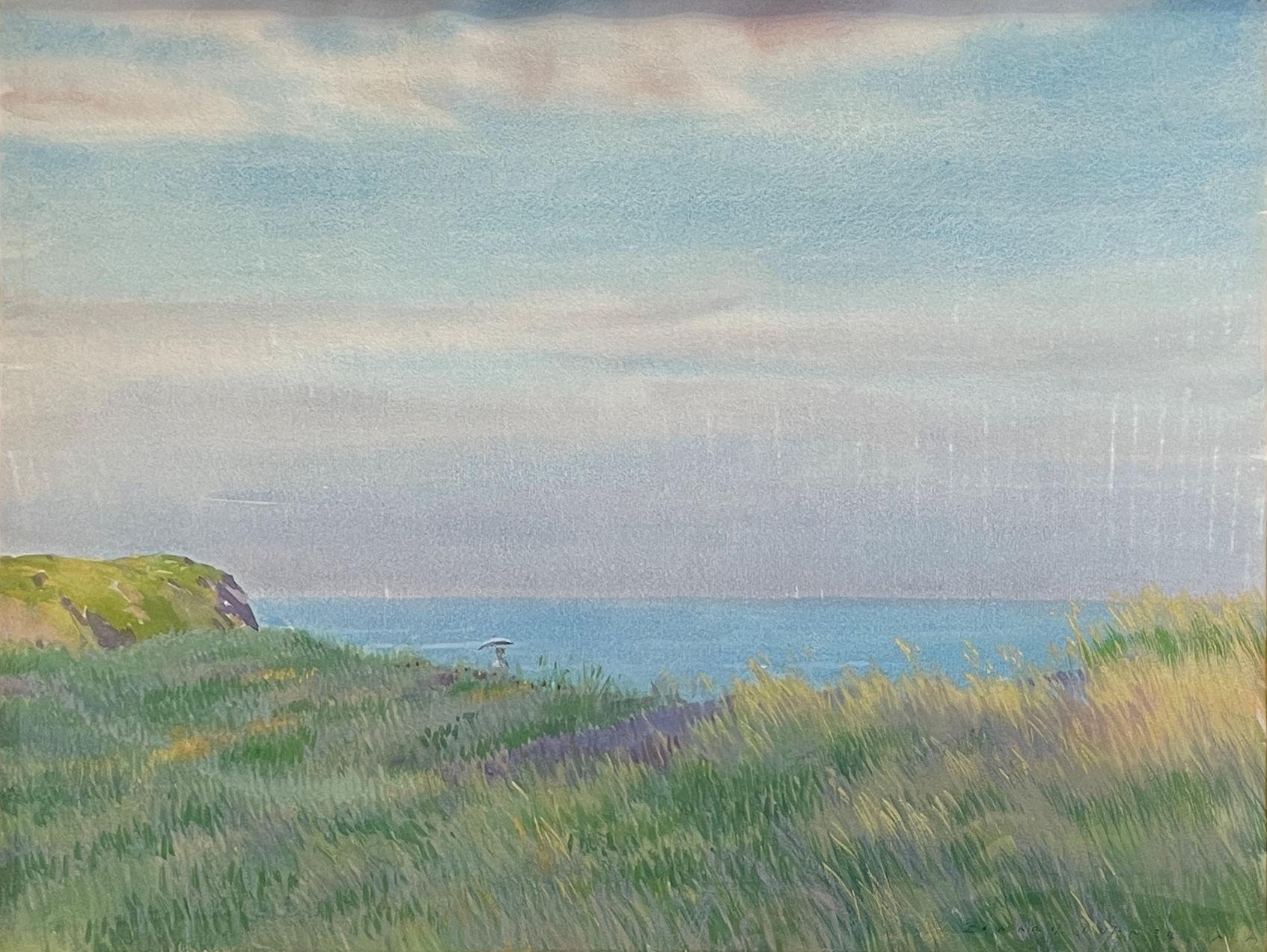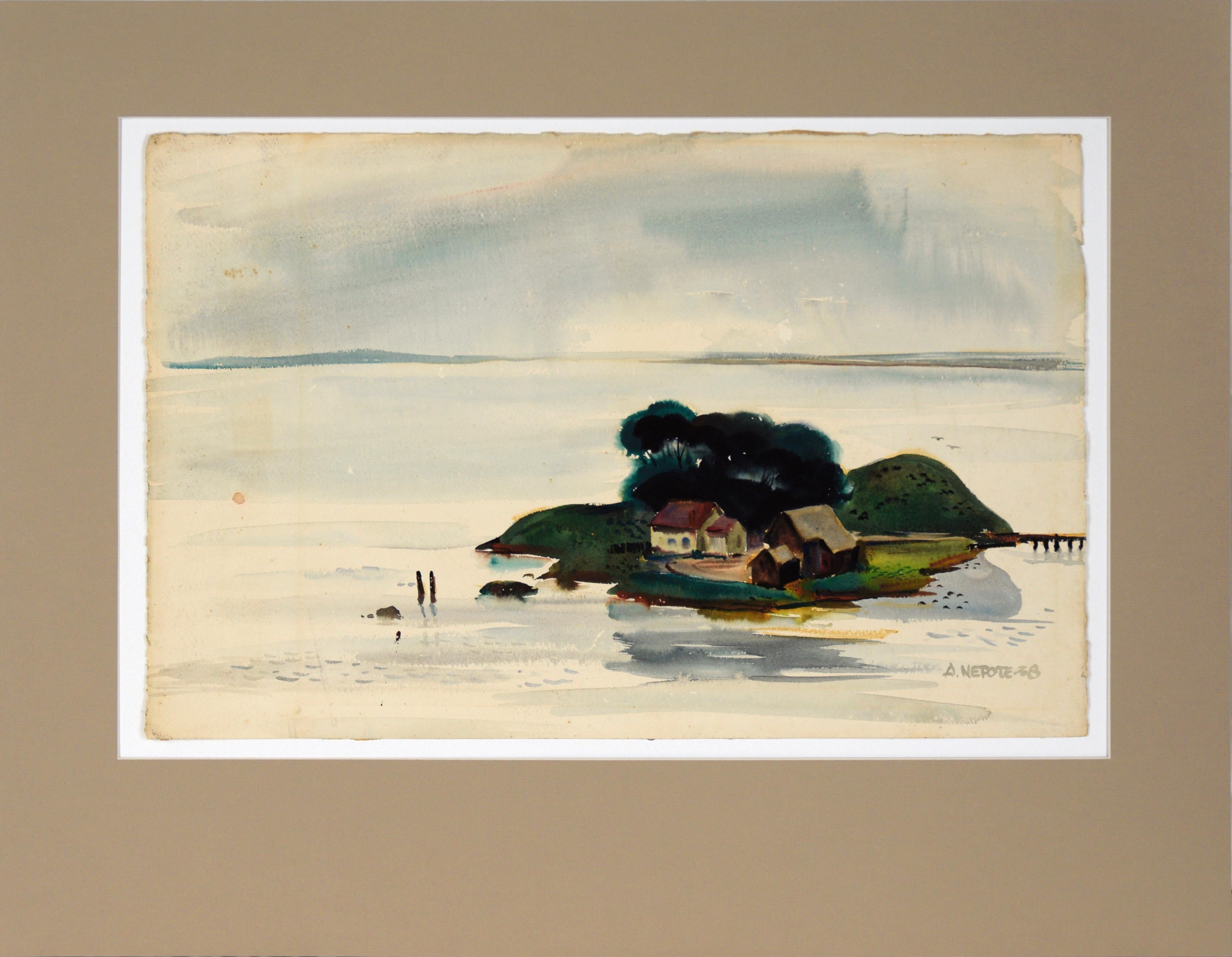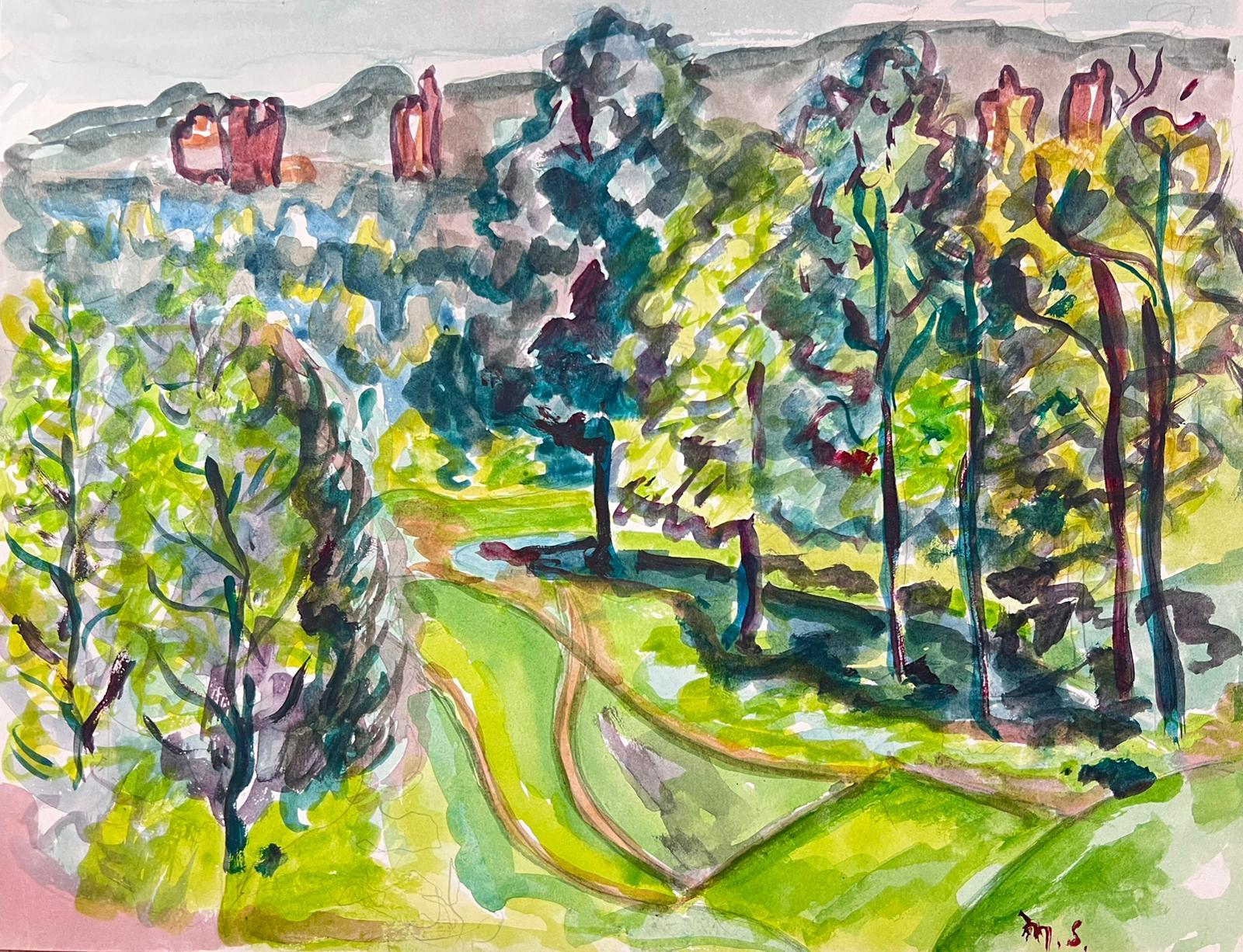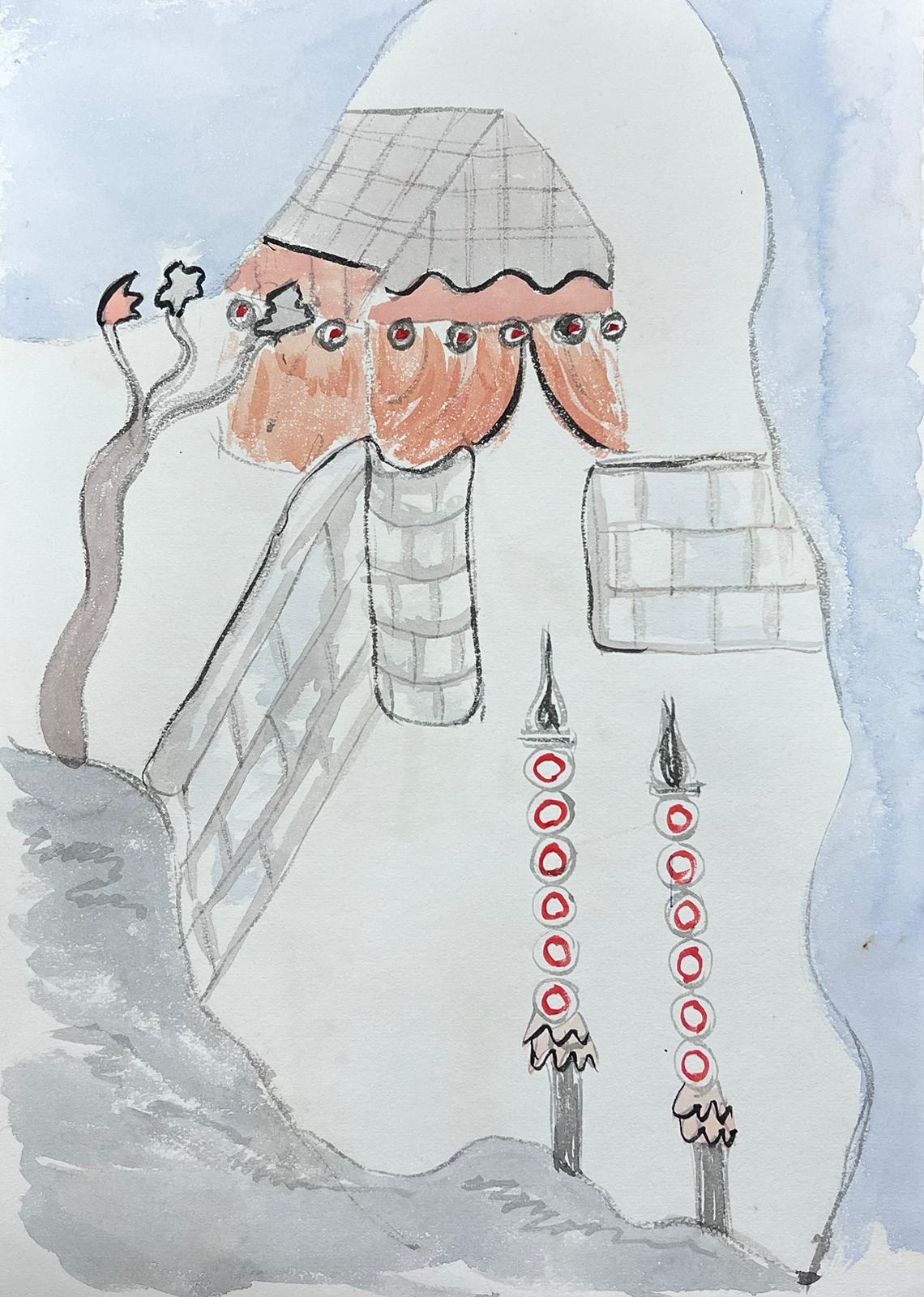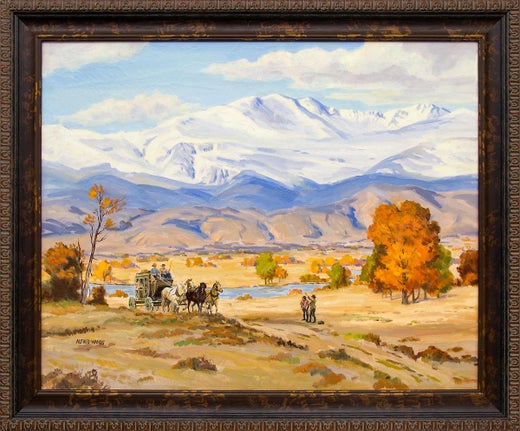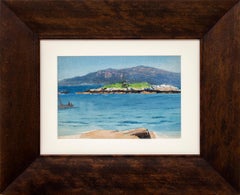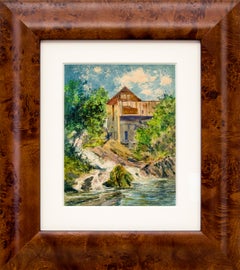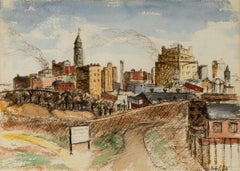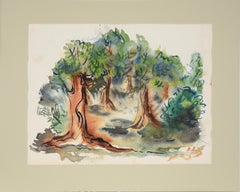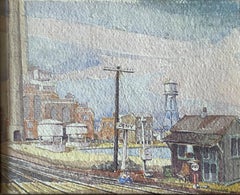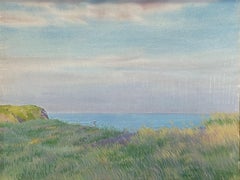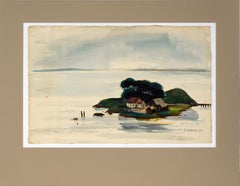Items Similar to Sangre de Cristo Mountains Watercolor Landscape Painting, Southern Colorado
Video Loading
Want more images or videos?
Request additional images or videos from the seller
1 of 16
Alfred WandsSangre de Cristo Mountains Watercolor Landscape Painting, Southern Colorado
About the Item
This original watercolor painting by Alfred Wands (1904-1998) captures the breathtaking beauty of the Sangre de Cristo Mountain range in Southern Colorado. Featuring a serene farm in the foreground with sweeping views of the mountains and expansive sky, the painting is characterized by bold, vibrant shades of blue, green, white, yellow, violet, and red. The dynamic interplay of color and the rugged mountain landscape evoke the timeless allure of the region.
The artwork is presented in a custom frame, with outer dimensions measuring 28 ¼ x 34 x 1 ¼ inches. The image size is 16 ¼ x 23 inches, making it a striking and captivating piece for any collection or space.
Alfred Wands was a prominent modernist artist known for his evocative landscape paintings that combined technical precision with a deep appreciation for nature’s beauty. His work remains highly regarded among collectors and art enthusiasts.
Perfect for those who appreciate the breathtaking vistas of Colorado and modernist interpretations of natural landscapes.
- Creator:Alfred Wands (1904 - 1998, American)
- Dimensions:Height: 28.25 in (71.76 cm)Width: 34 in (86.36 cm)Depth: 1.25 in (3.18 cm)
- Medium:
- Movement & Style:
- Period:
- Framing:Frame IncludedFraming Options Available
- Condition:very good vintage condition.
- Gallery Location:Denver, CO
- Reference Number:Seller: DCG-245671stDibs: LU2735059301
Alfred Wands
Born in Cleveland, Ohio, Alfred Wands graduated from the Cleveland School of Art with honors. Following that, he spent six months in Paris studying at the Academie Julian. In the late 1920’s, Wands returned to Ohio to teach painting at the Cleveland School of Art and the Cleveland Museum of Art. In 1930, Wands moved to Denver to direct the art program at Colorado Women’s College. He remained at the Women’s College for the next 17 years. During his time in Denver, Wands frequently traveled to Taos, New Mexico. He and his family spent eleven summers there between 1930 and 1940. By 1943, he had become the Camp Artist at the YMCA of the Rockies, where he taught summer art classes. He later became the Chairman of their Religious Programs and Adult Advisory Committees. By 1947, he quit his teaching position at the Colorado Woman's College to devote full time to his painting. By 1955, Wands opened his own studio and gallery in Estes Park, Colorado. Known as the "Dean of Colorado Landscape Painters", he served three times as the President of the Denver Artists Guild. He was the Chairman of the Denver Art Commission for 16 years. Wands was a long-time member of the Denver Artists Guild and the Denver Art Commission. He was also a member of the Cleveland Society of Artists, Ohio Watercolor Society, and Chicago Galleries Association. Exhibited: Carnegie Institute., 1928; PAFA, 1924, 1926, 1928, 1932, 1934; PAFA Ann., 1926, 1929-30; WFNY, 1939; AIC, 1934, 1954; Corcoran Gal. biennial, 1935; CMA, 1923-37, 1939, 1940; Kansas City AI, 1930-34; Denver Art Museum, 1931-51, 1953, 1954; MFA Houston, 1950, 1951; Denver Museum of Natural History, 1953 (solo); San Francisco AA, 1950-52. Awards: prizes, Paris Salon, 1936; CMA, 1923, 1930; Chaloner prize, NYC, 1926; CPLH, 1932; Denver Art Museum, 1932, 1945-51; Kansas City AI (medal); 1934; Denver Art Guild, 1958 Works Held: BM; CMA; CPLH, 1932; Cleveland Public Schools; Denver Public Schools; Denver Art Museum: murals, Colorado Woman’s College; Methodist Church, Sterling, CO; Kansas City AI; Denver University Further Reading: Schlosser, Elizabeth. Modern Art in Denver: 1916-1960, Eleven Denver Artists. Ocean View Books: 1993.
Who Was Who in American Art 1564-1975: 400 Years of Artists in America, Vol. III. Peter Hastings Falk, Georgia Kuchen and Veronica Roessler, eds., Sound View Press, Madison, Connecticut, 1999. 3 Vols. ©David Cook Galleries, LLC
About the Seller
5.0
Vetted Professional Seller
Every seller passes strict standards for authenticity and reliability
Established in 1979
1stDibs seller since 2013
286 sales on 1stDibs
Typical response time: <1 hour
- ShippingRetrieving quote...Shipping from: Denver, CO
- Return Policy
Authenticity Guarantee
In the unlikely event there’s an issue with an item’s authenticity, contact us within 1 year for a full refund. DetailsMoney-Back Guarantee
If your item is not as described, is damaged in transit, or does not arrive, contact us within 7 days for a full refund. Details24-Hour Cancellation
You have a 24-hour grace period in which to reconsider your purchase, with no questions asked.Vetted Professional Sellers
Our world-class sellers must adhere to strict standards for service and quality, maintaining the integrity of our listings.Price-Match Guarantee
If you find that a seller listed the same item for a lower price elsewhere, we’ll match it.Trusted Global Delivery
Our best-in-class carrier network provides specialized shipping options worldwide, including custom delivery.More From This Seller
View All19th Century 1925 California Coast Marine Landscape Watercolor, Rocks & Waves
By Charles Partridge Adams
Located in Denver, CO
American Impressionist California coastal watercolor painting by Charles Partridge Adams (1858-1942), circa 1925. This stunning piece captures the beauty of the coastline with vibran...
Category
1920s American Impressionist Landscape Paintings
Materials
Watercolor
Original Early 1900s Watercolor 'Mill Near Plainfield, New Hampshire' Landscape
By Charles Partridge Adams
Located in Denver, CO
"Mill Near Plainfield, New Hampshire" is an exquisite original watercolor painting by Charles Partridge Adams (1858-1942), created circa 1900. Signed by the artist in the lower left corner, this beautiful landscape depicts a mill nestled by a river, surrounded by trees and dramatic clouds. The painting is rendered in subtle tones of brown, green, gray, and blue, showcasing Adams’ skillful use of watercolor techniques. This artwork is presented in a custom frame, with outer dimensions measuring 13 ¾ x 12 ¼ x 1 ¼ inches and an image size of 7 x 5 inches.
About the Artist:
Charles Partridge Adams was born in Franklin, Massachusetts, and moved to Denver, Colorado, in 1876 in search of a better climate for his tuberculosis-stricken sisters. It was in Denver that Adams found his artistic calling, working at the Chain and Hardy Bookstore, where he received his only formal art training from Helen Chain, a former pupil of the renowned George Inness. Through her guidance, Adams was introduced to other prominent artists, including sculptor Alexander Phimister Proctor...
Category
20th Century American Impressionist Landscape Drawings and Watercolors
Materials
Watercolor
1950s Denver Skyline Painting – Graphite & Watercolor Colorado Cityscape Art
Located in Denver, CO
A captivating midcentury cityscape titled "Denver Skyline", this original 1950s watercolor and graphite painting offers a rare industrial-era view of lower downtown Denver, Colorado....
Category
1950s American Impressionist Landscape Paintings
Materials
Watercolor, Graphite
19th C. American Impressionist Gouache of Colorado Mountains in Spring
By Charles Partridge Adams
Located in Denver, CO
This original circa 1910s plein air field study by renowned Colorado landscape artist Charles Partridge Adams captures the serene beauty of the Rocky Mountains in a masterful display...
Category
1910s American Impressionist Landscape Paintings
Materials
Gouache
1940s Western Landscape of Silver Plume, Colorado, Framed Oil Pastel Drawing
By Elsie Haddon Haynes
Located in Denver, CO
A captivating early 20th-century Western mountain landscape by Colorado artist Elsie Haddon Haynes (1884–1963), this original oil pastel drawing captures the charming town of Silver Plume...
Category
1930s American Impressionist Landscape Drawings and Watercolors
Materials
Oil Pastel
1930s American Modernist Colorado Winter Landscape Watercolor, Trees, Mountains
Located in Denver, CO
This 1938 watercolor painting by American Modernist artist Turner B. Messick depicts a serene winter landscape, likely set in Colorado. The scene features a bare tree in the foregrou...
Category
1930s American Modern Landscape Paintings
Materials
Watercolor
You May Also Like
Through The Trees - Original Watercolor on Paper
Located in Soquel, CA
Through The Trees - Original Watercolor on Paper
Original watercolor painting depicting a grove of vibrant green trees by Bertram Spencer (American, 1918-1992).
Presented in a lig...
Category
Mid-20th Century American Impressionist Landscape Drawings and Watercolors
Materials
Paper, Watercolor
"Train Station, " Max Kuehne, Industrial City Scene, American Impressionism
By Max Kuehne
Located in New York, NY
Max Kuehne (1880 - 1968)
Train Station, circa 1910
Watercolor on paper
8 1/4 x 10 1/4 inches
Signed lower right
Provenance:
Private Collection, Illinois
Max Kuehne was born in Halle, Germany on November 7, 1880. During his adolescence the family immigrated to America and settled in Flushing, New York. As a young man, Max was active in rowing events, bicycle racing, swimming and sailing. After experimenting with various occupations, Kuehne decided to study art, which led him to William Merritt Chase's famous school in New York; he was trained by Chase himself, then by Kenneth Hayes Miller. Chase was at the peak of his career, and his portraits were especially in demand. Kuehne would have profited from Chase's invaluable lessons in technique, as well as his inspirational personality. Miller, only four years older than Kuehne, was another of the many artists to benefit from Chase's teachings. Even though Miller still would have been under the spell of Chase upon Kuehne's arrival, he was already experimenting with an aestheticism that went beyond Chase's realism and virtuosity of the brush. Later Miller developed a style dependent upon volumetric figures that recall Italian Renaissance prototypes.
Kuehne moved from Miller to Robert Henri in 1909. Rockwell Kent, who also studied under Chase, Miller, and Henri, expressed what he felt were their respective contributions: "As Chase had taught us to use our eyes, and Henri to enlist our hearts, Miller called on us to use our heads." (Rockwell Kent, It's Me O Lord: The Autobiography of Rockwell Kent. New York: Dodd, Mead and Co., 1955, p. 83). Henri prompted Kuehne to search out the unvarnished realities of urban living; a notable portion of Henri's stylistic formula was incorporated into his work.
Having received such a thorough foundation in art, Kuehne spent a year in Europe's major art museums to study techniques of the old masters. His son Richard named Ernest Lawson as one of Max Kuehne's European traveling companions. In 1911 Kuehne moved to New York where he maintained a studio and painted everyday scenes around him, using the rather Manet-like, dark palette of Henri.
A trip to Gloucester during the following summer engendered a brighter palette. In the words of Gallatin (1924, p. 60), during that summer Kuehne "executed some of his most successful pictures, paintings full of sunlight . . . revealing the fact that he was becoming a colorist of considerable distinction." Kuehne was away in England the year of the Armory Show (1913), where he worked on powerful, painterly seascapes on the rocky shores of Cornwall. Possibly inspired by Henri - who had discovered Madrid in 1900 then took classes there in 1906, 1908 and 1912 - Kuehne visited Spain in 1914; in all, he would spend three years there, maintaining a studio in Granada. He developed his own impressionism and a greater simplicity while in Spain, under the influence of the brilliant Mediterranean light. George Bellows convinced Kuehne to spend the summer of 1919 in Rockport, Maine (near Camden). The influence of Bellows was more than casual; he would have intensified Kuehne's commitment to paint life "in the raw" around him.
After another brief trip to Spain in 1920, Kuehne went to the other Rockport (Cape Ann, Massachusetts) where he was accepted as a member of the vigorous art colony, spearheaded by Aldro T. Hibbard. Rockport's picturesque ambiance fulfilled the needs of an artist-sailor: as a writer in the Gloucester Daily Times explained, "Max Kuehne came to Rockport to paint, but he stayed to sail." The 1920s was a boom decade for Cape Ann, as it was for the rest of the nation. Kuehne's studio in Rockport was formerly occupied by Jonas Lie.
Kuehne spent the summer of 1923 in Paris, where in July, André Breton started a brawl as the curtain went up on a play by his rival Tristan Tzara; the event signified the demise of the Dada movement. Kuehne could not relate to this avant-garde art but was apparently influenced by more traditional painters — the Fauves, Nabis, and painters such as Bonnard. Gallatin perceived a looser handling and more brilliant color in the pictures Kuehne brought back to the States in the fall. In 1926, Kuehne won the First Honorable Mention at the Carnegie Institute, and he re-exhibited there, for example, in 1937 (Before the Wind). Besides painting, Kuehne did sculpture, decorative screens, and furniture work with carved and gilded molding. In addition, he designed and carved his own frames, and John Taylor Adams encouraged Kuehne to execute etchings. Through his talents in all these media he was able to survive the Depression, and during the 1940s and 1950s these activities almost eclipsed his easel painting. In later years, Kuehne's landscapes and still-lifes show the influence of Cézanne and Bonnard, and his style changed radically.
Max Kuehne died in 1968. He exhibited his work at the National Academy of Design, the Art Institute of Chicago, the Carnegie Institute in Pittsburgh, the Memorial Art Gallery of the University of Rochester, and in various New York City galleries. Kuehne's works are in the following public collections: the Detroit Institute of Arts (Marine Headland), the Whitney Museum (Diamond Hill...
Category
1910s American Impressionist Landscape Drawings and Watercolors
Materials
Paper, Watercolor
"Monhegan Island, Maine, " Edward Dufner, American Impressionism Landscape View
By Edward Dufner
Located in New York, NY
Edward Dufner (1872 - 1957)
Monhegan Island, Maine
Watercolor on paper
Sight 16 x 20 inches
Signed lower right
With a long-time career as an art teacher and painter of both 'light' and 'dark', Edward Dufner was one of the first students of the Buffalo Fine Arts Academy to earn an Albright Scholarship to study painting in New York. In Buffalo, he had exchanged odd job work for drawing lessons from architect Charles Sumner. He also earned money as an illustrator of a German-language newspaper, and in 1890 took lessons from George Bridgman at the Buffalo Fine Arts Academy.
In 1893, using his scholarship, Dufner moved to Manhattan and enrolled at the Art Students League where he studied with Henry Siddons Mowbray, figure painter and muralist. He also did illustration work for Life, Harper's and Scribner's magazines.
Five years later, in 1898, Dufner went to Paris where he studied at the Academy Julian with Jean-Paul Laurens and privately with James McNeill Whistler. Verification of this relationship, which has been debated by art scholars, comes from researcher Nancy Turk who located at the Smithsonian Institution two 1927 interviews given by Dufner. Turk wrote that Dufner "talks in detail about Whistler, about how he prepared his canvasas and about numerous pieces he painted. . . A great read, the interview puts to bed" the ongoing confusion about whether or not he studied with Whistler.
During his time in France, Dufner summered in the south at Le Pouleu with artists Richard Emil Miller...
Category
Early 20th Century American Impressionist Landscape Drawings and Waterco...
Materials
Paper, Watercolor
Island in the San Francisco Bay, Mid Century Landscape by Alexander Nepote
By Alexander Nepote
Located in Soquel, CA
Mid Century Island in the San Francisco Bay Landscape by Alexander Nepote
Lovely late 1930's Impressionist watercolor of a Bay Area island by listed California artist Alexander Nepo...
Category
1930s American Impressionist Landscape Paintings
Materials
Paper, Watercolor
$1,720 Sale Price
20% Off
Vibrant Watercolor Landscape of a Sunlit Forest and Rolling Hills
Located in Cirencester, Gloucestershire
Vibrant Watercolor Landscape
original watercolour painting on artist paper
signed by Marjorie Schiele (1913-2008) *see notes below
piece of paper is 9.5 x 12.5 inches
In good conditi...
Category
Early 20th Century American Impressionist Landscape Paintings
Materials
Watercolor
Whimsical Watercolour of an Abstract Architectural Scene with Unique Details
Located in Cirencester, Gloucestershire
Abstract Architectural Scene
original watercolour painting on artist paper
by Marjorie Schiele (1913-2008) *see notes below
piece of paper is 14 x 10 inches
In good condition
provena...
Category
Early 20th Century American Impressionist Landscape Paintings
Materials
Watercolor
